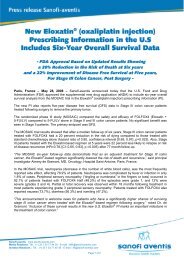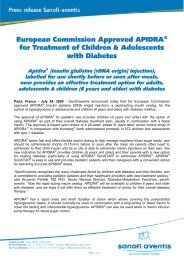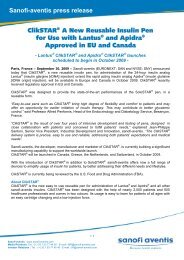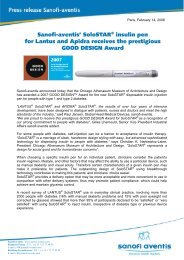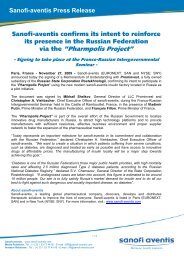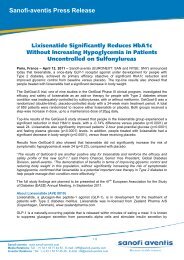Press release Sanofi-aventis
Press release Sanofi-aventis
Press release Sanofi-aventis
Create successful ePaper yourself
Turn your PDF publications into a flip-book with our unique Google optimized e-Paper software.
<strong>Press</strong> <strong>release</strong> <strong>Sanofi</strong>-<strong>aventis</strong><br />
New ADA/EASD Treatment Recommendations<br />
Timely Use of Basal Insulin reinforced<br />
as a “Core Therapy” for Type 2 Diabetes<br />
- Experts recommend considering a basal insulin or sulfonylurea<br />
when treatment goals not achieved with metformin alone -<br />
Paris, France - October 30, 2008 – <strong>Sanofi</strong>-<strong>aventis</strong> commends the American Diabetes Association<br />
(ADA) and the European Association for the Study of Diabetes (EASD) for developing updated<br />
treatment recommendations for type 2 diabetes.<br />
Designed by a team of diabetes experts, the updated recommendations provide healthcare<br />
professionals with a consensus algorithm that further establishes basal insulins, such as LANTUS ®<br />
or a sulfonylurea such as AMARYL ® , as two preferred second-line treatment options for people with<br />
diabetes who are unable to achieve glycemic control targets with lifestyle intervention and<br />
metformin alone.<br />
For the first time, the ADA/EASD diabetes treatment recommendations are divided into two tiers.<br />
Tier 1: “Well Validated Core Therapies”<br />
These interventions represent the most established, the most effective and the most cost-effective<br />
therapeutic strategy for achieving target glycemic goals. The tier one algorithm which includes basal<br />
insulins, is the preferred route of therapy for most people with type 2 diabetes.<br />
Tier 2: “Less Well Validated Therapies”<br />
These interventions represent appropriate treatment options for certain people, but were grouped in<br />
tier two due to limited clinical experience or safety caution. Pioglitazone and GLP-1 agonists, one of<br />
the newest classes of diabetes medications, were placed in this group.<br />
The updated recommendations describe insulin as the “most effective” treatment for lowering<br />
glycaemia and emphasize the need for “early addition of insulin therapy in patients who do not meet<br />
target goals.” This is especially important for people with A1C> 8.5%. However, in actual clinical<br />
practice, the use of insulin is often delayed until A1C approaches 9%, and many people with type 2<br />
diabetes have already developed diabetes-related complications by the time they begin treatment<br />
with insulin. Early addition of basal insulin to oral therapy may improve glycemic control, which can<br />
reduce the risk of complications. Premix regimens are not mentioned in the guidelines algorithm<br />
and are not recommended for initiation of insulin therapy.<br />
“Basal insulin is an important, yet underutilized, treatment option for many people living with type 2<br />
diabetes. The updated algorithm provides physicians with additional guidance about when it may be<br />
appropriate to initiate it”, said Alexandre Moreau, Vice President, Diabetes-Metabolism Franchise.<br />
“In the future, we hope more patients will benefit from the effectiveness and ease-of-use of<br />
LANTUS ® , the only true once-daily basal therapy from initiation to insulin intensification.”<br />
<strong>Sanofi</strong>-<strong>aventis</strong> www.sanofi-<strong>aventis</strong>.com<br />
Media Relations: Tel. : (+) 33 1 53 77 44 50 - E-mail : MR@sanofi-<strong>aventis</strong>.com<br />
Investor Relations : Tel. : (+) 33 1 53 77 45 45 - E-mail : IR@sanofi-<strong>aventis</strong>.com<br />
Page 1 of 4
<strong>Sanofi</strong>-<strong>aventis</strong> offers a complete range of medications (such as Lantus ® , Apidra ® and Amaryl ® ) and<br />
delivery devices (such as SoloSTAR ® ) to combat diabetes at each stage of the disease.<br />
About LANTUS ® (insulin glargine [rDNA origin])<br />
LANTUS ® is indicated for once-daily subcutaneous administration in the treatment of adult patients<br />
with type 2 diabetes mellitus who require basal (long-acting) insulin for the control of hyperglycemia<br />
and for adult and pediatric patients (6 years and older) with type 1 diabetes mellitus. LANTUS ®<br />
demonstrates a peakless and sustained concentration/time profile over 24 hours thus reducing the<br />
risk of hypoglycemia and allowing a constant and high efficacy over 24h with one single daily<br />
injection. LANTUS ® is the number one prescribed insulin worldwide.<br />
About APIDRA ® (insulin glulisine [rDNA origin])<br />
APIDRA ® is a rapid-acting insulin analog with a unique zinc-free molecular structure that maintains<br />
a rapid onset and a short duration of action, indicated for adults, adolescents and children with<br />
diabetes. APIDRA ® offers patients mealtime dosing flexibility—it can be taken shortly (0-15 min)<br />
before or soon after the meal. APIDRA ® is also flexible for use in a wide range of patients from lean<br />
to obese. APIDRA ® is the logical partner to LANTUS ® once prandial insulin is required.<br />
About LANTUS ® SoloSTAR ® and APIDRA ® SoloSTAR ®<br />
SoloSTAR ® is a new, easy-to-use disposable pen for administration of LANTUS ® and APIDRA ® .<br />
SoloSTAR ® allows administering doses from 1 up to 80 units, in one unit increments, in one<br />
injection. SoloSTAR offers a 33% greater maximum capacity than other disposable insulin pens.<br />
SoloSTAR ® uses a simple, intuitive design with an easy-to-read display, and requires only a few<br />
steps to use it properly. SoloSTAR ® is small, discreet and eliminates the need for the patient to<br />
change insulin cartridges. Easy-to-use and easy-to-inject, SoloSTAR ® reduces the injection force by<br />
30% or more in comparison to other most broadly available pens in its class.<br />
A recent survey of LANTUS ® SoloSTAR ® use in everyday clinical practice, involving more than<br />
2000 people with diabetes (16% with manual dexterity problems and 15% with poor eyesight not<br />
corrected by glasses) showed that more than 95% of participants declared to be “satisfied” or “very<br />
satisfied” with using SoloSTAR ® to inject insulin, irrespective of diabetes type or previous device<br />
experience.<br />
LANTUS ® SoloSTAR ® and APIDRA ® SoloSTAR ® were approved by the EMEA in September 2006;<br />
LANTUS ® SoloSTAR ® was approved by the FDA in April 2007. LANTUS ® SoloSTAR ® and<br />
APIDRA ® SoloSTAR ® are launched in France, UK, Italy, Spain, Germany, Netherlands, Slovakia,<br />
Slovenia, Sweden, Norway, Iceland, Poland, Austria, Denmark, Estonia, Finland, Greece, Hungary,<br />
Ireland, Latvia, Australia, Lithuania, Lebanon, South Africa, Cyprus, Israel, Jordan, Argentina,<br />
Korea, Turkey, Egypt, Tunisia, Romania, Chile, Colombia, Indonesia, Costa Rica, Dominican Rep,<br />
Peru, Georgia, Uruguay, Curacao, Nicaragua, Singapore, Guatemala and Switzerland. LANTUS ®<br />
SoloSTAR ® is launched in the US, Canada, Taiwan, Japan, Venezuela, Syria, China, Iran,<br />
Thailand, Malaysia, Hong Kong and India. The preparation for launches in other countries is<br />
planned during 2008 and 2009.<br />
***<br />
Page 2 of 4
The Chicago Athenaeum Museum of Architecture and Design awarded a 2007 GOOD DESIGN<br />
Award for the new SoloSTAR ® disposable insulin injection pen for people with type 1 and type 2<br />
diabetes. The Museum’s historic GOOD DESIGN program was founded in Chicago in 1950 by<br />
Edgar J.Kaufmann, Jr. with the participation of some of America’s most important designers. Every<br />
year the jury meets in New York and select products and graphics worthy of the GOOD DESIGN<br />
Award for design distinction. GOOD DESIGN remains the oldest and most important Awards<br />
program worldwide.<br />
About sanofi-<strong>aventis</strong>’ pen portfolio<br />
<strong>Sanofi</strong>-<strong>aventis</strong> having 85 years of innovation in the diabetes is committed to offering people with<br />
diabetes an integrated system of insulin products and delivery devices. In addition to the<br />
SoloSTAR ® , the pen portfolio available for LANTUS ® and APIDRA ® includes the OptiSet ®<br />
disposable pen, the OptiClik ® and OptiPen ® Pro reusable pens, and the Autopen ® 24 from Owen<br />
Mumford.<br />
About AMARYL ®<br />
AMARYL ® (Glimepiride) is a second-generation sulphonylurea that effectively controls glycaemia in<br />
type 2 diabetes patients and has a more rapid onset and longer duration of action than firstgeneration<br />
agents. It is once a day and well tolerated. AMARYL ® is available in more that hundred<br />
countries.<br />
A fixed-dose combination of glimepiride plus Metformin in a single presentation (AMARYL M ® ) has<br />
been developed recently. The fixed dose treatment is more efficacious than either agent alone in<br />
patients with type 2 diabetes and has equal efficacy compared with the free combination of<br />
glimepiride and Metformin. AMARYL M ® was launched in 2007.<br />
About Diabetes<br />
Diabetes is a chronic, progressive widespread disease in which the body reduces or does not<br />
produce or properly use insulin – the hormone needed to convert glucose (sugar) into energy. In<br />
2008 over 250 million people worldwide are living with diabetes. This number would dramatically<br />
increase up to 380 million by 2025. It is estimated more than 24 million Americans have diabetes.<br />
At the same time, more than 40% of those diagnosed are not achieving the general blood sugar<br />
control. The A1C test reflects average blood glucose levels over a two- to three-month period.<br />
Without proper insulin production and action, glucose remains in the blood, leading to chronic<br />
hyperglycaemia (raised blood sugar). This can result in short and long-term complications, many of<br />
which, if not prevented and left untreated, can be fatal. All have the potential to reduce the quality of<br />
life of people with diabetes and their families.<br />
The most common long-term complications are:<br />
• Diabetic nephropathy (kidney disease), which may result in total kidney failure and in the<br />
need for dialysis or kidney transplant.<br />
• Diabetic eye disease (retinopathy and macular oedema), damage to the retina of the eye<br />
which can lead to vision loss.<br />
• Diabetic neuropathy (nerve disease), which can ultimately lead to ulceration and amputation<br />
of the feet and lower limbs.<br />
• Cardiovascular disease, which affects the heart and blood vessels and may cause fatal<br />
complications such as coronary heart disease (leading to a heart attack) and stroke.<br />
Page 3 of 4
Diabetes is the fourth leading cause of death by disease globally. Every year, 3.8 million people die<br />
from diabetes-related causes.<br />
About sanofi-<strong>aventis</strong><br />
<strong>Sanofi</strong>-<strong>aventis</strong>, a leading global pharmaceutical company, contributes to improving life by providing<br />
a broad offering of medicines, vaccines, and integrated healthcare solutions adapted to local needs<br />
and means. <strong>Sanofi</strong>-<strong>aventis</strong> is listed in Paris (EURONEXT : SAN) and in New York (NYSE : SNY).<br />
Contact:<br />
Anna Radjanova, MD<br />
Tel: + 33 6 07 28 61 63<br />
E-mail: anna.radjanova@sanofi-<strong>aventis</strong>.com<br />
Page 4 of 4



